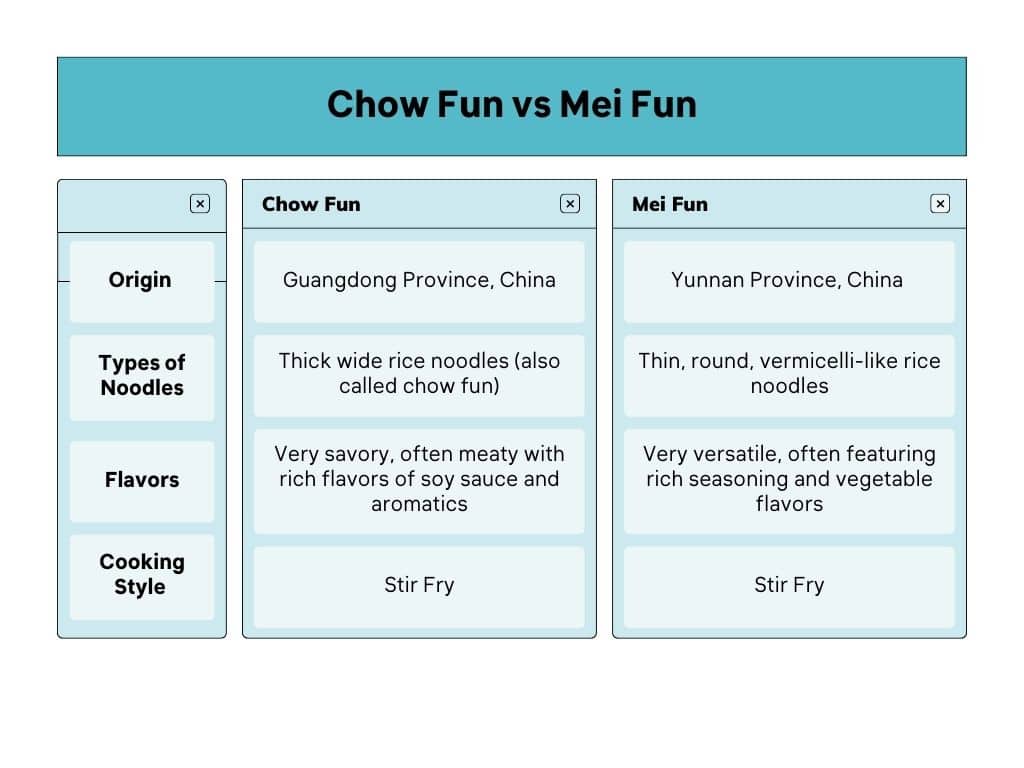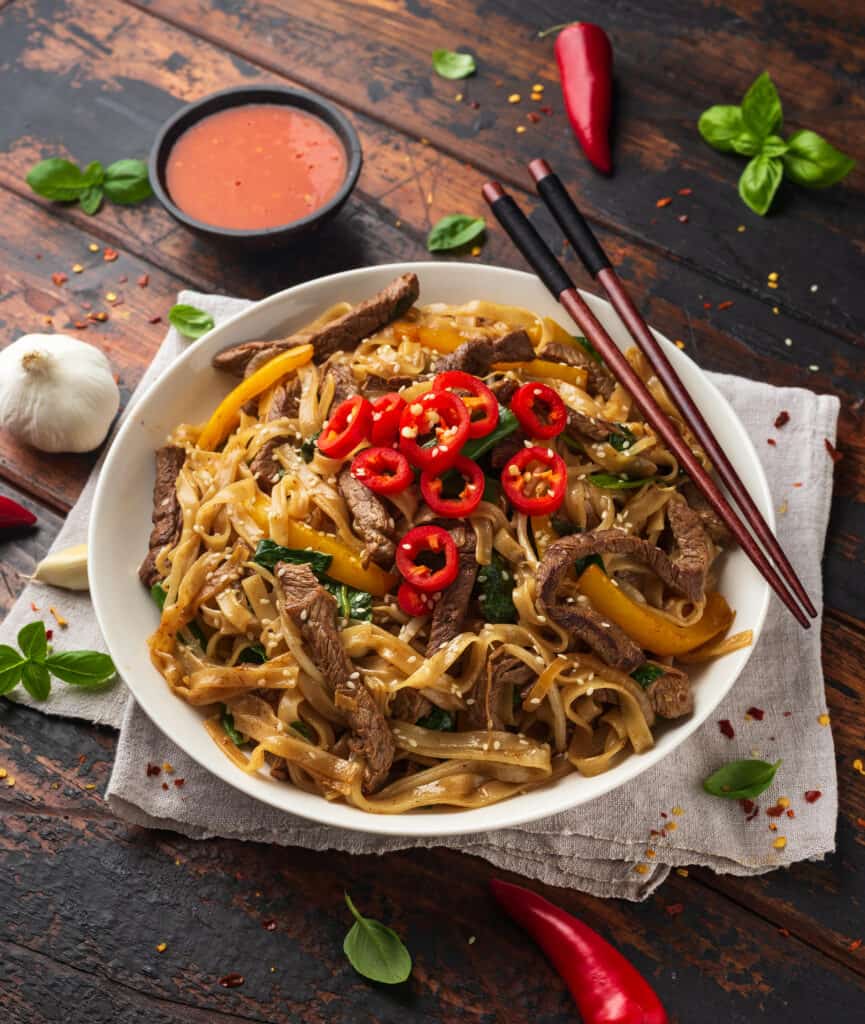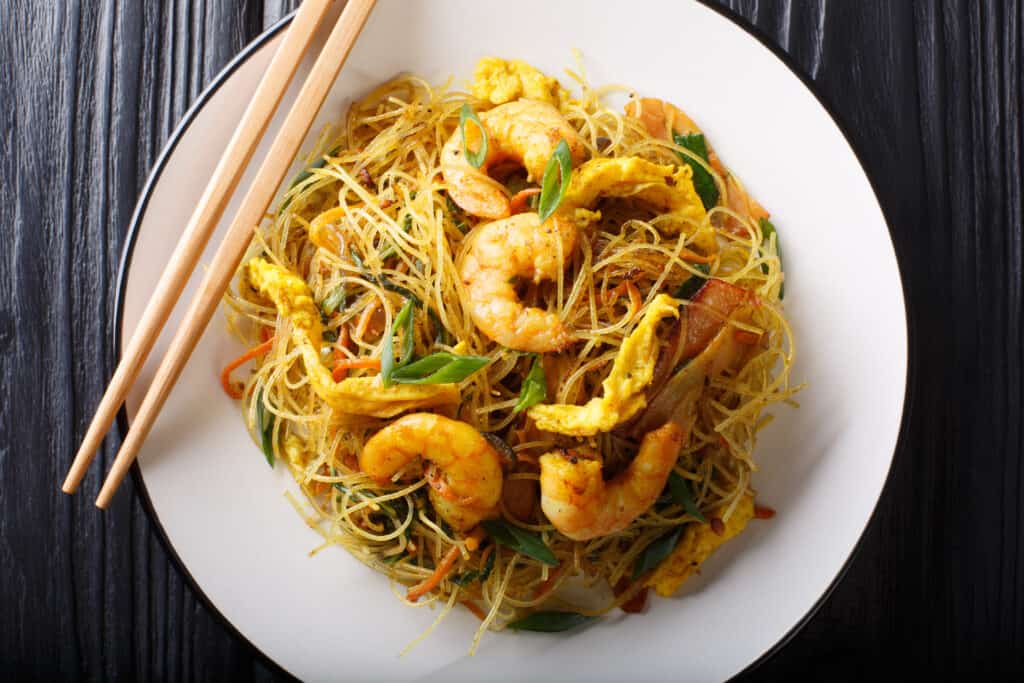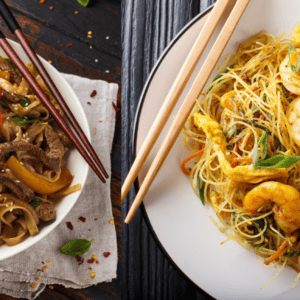Asian noodle dishes are some of the most popular foods in the world, and there are hundreds of different kinds of noodle dishes to choose from. Known for their rich, savory flavors and versatility, both Chow Fun and Mei Fun are family favorites.
But what’s the difference between Chow Fun and Mei Fun?
Chow fun and mei fun are both Chinese noodles but the key difference is the thickness of the noodle. Chow fun is wide and thick while mei fun is thin, similar to a vermicelli. Chow fun’s hearty texture is better for stir-fries while mei fun is more delicate and best in soups and salads.
Let’s take a deeper look.

What Is Chow Fun?

Chow fun is a flat rice noodle dish native to Guangdong and has become a staple of Cantonese cuisine and a popular and easy dish to make at home.
It’s traditionally made with thicker noodles, that’s one of the primary differences between Chow Fun and Mei Fun. Think Fettuccine but with rice noodles instead of wheat and egg noodles.
Chow fun is both the name of the noodles and the dish made with them. You can make a similar dish with different noodles (or even over rice), but it won’t be chow fun.
Chow fun is traditionally made as a stir fry. It takes advantage of the high heat of a wok to quickly cook ingredients and give the dish a lot of flavors. Chow fun recipes range from making the best use of limited ingredients to complex dishes packed with veggies depending on your personal preference, cooking style, and budget.
Different Types of Chow Fun
There are two basic kinds of chow fun, wet and dry.
Dry chow fun is a stir fry with a good amount of oil, and the protein in the dish is always paired with mung bean sprouts. You’ll still use soy sauce and other flavoring ingredients, but just enough to flavor and color the dish, not enough to create a sauce.
Wet chow fun is similar, and also cooked as a stir fry, but the dish includes at least one vegetable like green beans or bok choy, and tossed in a flavorful sauce when the meal is almost finished.
Wet chow fun is also sometimes called Hong Kong-style chow fun.
Beef is the most common and most popular protein choice for chow fun. But, other than the noodles, and the bean sprouts in dry chow fun, the ingredients are really flexible and versatile.
How Do You Make Chow Fun?
When it comes to making chow fun you need to have a few things:
● A high-heat wok or deep skillet
● High-heat oil (preferably peanut or sesame oil)
● Chow fun noodles
Your other ingredients, including the choice of protein and vegetables, are more up to you. Dry chow fun offers concentrated flavors, chewy noodles, and crisp, flavorful vegetables. Wet chow fun can be a little more variable, it’s often slightly sweeter thanks to the sauce, and offers a mellower, but more complex flavor.
Delicious Chow Fun Ingredients
Not sure what to add to your chow fun? Beef is the most common protein, but there are other options. Chicken and pork both work and fried tofu can be a delicious vegetarian or vegan addition. Eggs are another great source of protein, on their own or combined with another protein.
When it comes to vegetables, green beans, bok choy, mung bean sprouts, cabbage, sugar snap peas, broccoli, onions, and green onions are all great choices. But you can also just raid your refrigerator and use whatever vegetables you have on hand.
Great Chow Fun Recipes You Should Try
The Woks of Life has a fantastic Beef Chow fun recipe featuring green beans, scallions, and ginger in a dark soy sauce recipe. They walk you through step by step, and even talk about proper wok technique and why it matters for the flavor of your dish.
A more stylized version of Chow Fun is the delicious Hawai’ian take on the dish offered by Onolicious Hawai’i. This peppery, garlicky take on chow fun is packed with vegetables and flavor!
What Is Mei Fun?

On the surface, Mei Fun looks very similar. It’s another noodle stir fry featuring thinly sliced proteins (or whole shrimp), roughly chopped vegetables, and a pile of delicious rice noodles. But some key differences make mei fun unique and a wider range of styles and preparations.
The core of mei fun though? Just like chow fun, it’s all about the noodles. In this case, very thin vermicelli-like rice noodles. Slightly thinner than angle hair, and with a firmer bite, mei fun is a great way to shake up your noodle game.
Different Styles Of Mei Fun
Like chow fun, mei fun is both the name of the dish and also the noodles. However, in the case of mei fun, thin rice noodles are incredibly versatile and used in a wide variety of dishes. We’re not going to talk about the soups or spring rolls made with mei fun noodles though, only the stir-fry dish that shares their name.
Mei fun originates in the Yunnan province of China, but one of the most popular versions of the dish is actually from Singapore – the Singapore noodle! Here are a few different versions of Mei Fun:
Traditional Mei Fun: Traditional mei fun is a dry noodle stir fry made with a good amount of oil, fresh vegetables, and often chicken and eggs. However, other proteins are also used, and you can even make vegetarian/vegan mei fun.
Singapore Noodle: Singapore noodles are bright yellow curried noodles (the color comes from turmeric in the curry), often made with bean sprouts, scallions, and bell peppers. They can be served with a wide variety of proteins, but shrimp, char siu, or combinations of proteins are particularly popular.
Local Styles: Mei fun is pretty much always a dry stir fry. Too much sauce makes the noodles slippery and hard to eat. But aside from that, the sky is the limit in terms of your interpretation. Flavors are widely variable, as are the key ingredients. So, other than the traditional and Singapore versions of Mei Fun, you can choose your own combinations of three core ingredients: Mei Fun noodles, protein, and vegetables.
How Do You Make Mei Fun?
The main trick with mei fun is getting all the ingredients perfectly cooked without losing the firm texture of the noodles. Cook them too long and they can get mushy. So the trick is to cook the protein and vegetables first in oil and spices, and then add the pre-cooked noodles at the end.
Toss the noodles to coat and combine all the ingredients, and you’re done!
Mei Fun Ingredients and Toppings To Experiment With

Mei fun is made with mei fun noodles, oil, a little soy sauce, and other spices and flavorings of your choice. Beyond that, there are a lot of vegetables and proteins to choose from like chicken, shrimp, char siu (Chinese barbecue pork), cabbage, peppers (bell peppers and spicy peppers), onions, carrots, scallions, bean sprouts, shallots, zucchini, shitake mushrooms, and bamboo shoots.
Top Mei Fun Recipes You’re Sure To Love
The Woks of Life has another delicious recipe for us, this time for chicken mei fun. They’ll walk you through the whole process step by step, and also explain how to build flavor and make all of your ingredients shine.
For a delicious version of Singapore Noodles, with a step-by-step process and beautiful photos to help guide your cooking, we’d recommend this recipe from The Wanderlust Kitchen.
Of course, with both recipes, feel free to shake things up a little or substitute some ingredients.
Wrapping Up: What are the key differences between chow fun and mei fun?
There are a lot of similarities between chow fun and mei fun, and a lot of room to get creative and experiment with different ingredients until you find your favorite recipe. When it comes to differences, it’s all about the textures and noodles, here are the keys:
● Origins: both chow fun and mei fun are originally from China, but they are from different provinces, and the most common flavors speak to the flavors and culture of their province of origin.
● Noodles: both of these dishes share the name of the noodles used, but they’re a study in contrasts. Mei Fun uses thin stringy rice noodles, while chow fun prefers wide thick almost chewy rice noodles.
● Ingredients: there is a lot of overlap in the ingredients in these dishes, but where chow fun tends to be a bit more savory and only uses 1-3 vegetables on average, mei fun is often a little sweeter, spicier, and uses a wider variety of vegetables in each version.
● Sauces: Chow Fun comes in both wet and dry versions, which gives you a ton of room to play with flavors and textures in the finished meal. Mei fun is always a dry noodle and highlights the flavors of the herbs, spices, and aromatics included in the dish.
Frequently Asked Questions (FAQs)
Q1: Which Is Healthier, Mei Fun or Chow Fun?
Both mei fun and chow fun can be very healthy depending on your ratio of noodles, protein, and vegetables. Both can have trouble with large servings of carbs and sodium. Neither dish calls for much sugar. But, mei fun takes a slight edge in that you can put a larger variety of vegetables in the dish.
Q2: Is Chow Fun Spicy?
It can be, but you don’t have to make chow fun spicy if you don’t want to. To avoid excess spiciness, you can use ginger, but skip cayenne pepper, and other sources of capsaicin. Wet chow fun is often milder than dry chow fun.
Q3: What’s The Difference Between Mei Fun And Rice Noodles?
Mei fun is a type of rice noodle, thin, round, and long, but there are dozens of different varieties of rice noodles in general.
Q4: Are Lo Mein Noodles Or Rice Noodles Healthier?
Lo mein noodles are made from wheat and eggs, which means they are higher in carbs and fats compared to rice noodles, but in both cases what you cook the noodles in (sauces and oils) that determine how healthy each noodle is.
Chow Fun vs Mei Fun

Instructions
- Choose Your Favorite Recipe
- Click the link to view the recipe
- Follow the linked instructions
- Enjoy!

